With the changing of moped specifications to footrest, kick-start, and limited to 30mph, Honda, Suzuki, and Yamaha almost simultaneously started embracing new 50cc designs without pedals, and the first concepts of mini-scooters in the early 1980s.
Suzuki’s first effort was the unfortunately styled FS50 Scooterette from May 1980, which seemed to have quietly been dumped by 1982, suggesting it had been something of a failure, but these were early days, and the other manufacturers were also having some ‘bad moment designs’ as everyone was still trying to figure out which way to go at this time. (For the FS50, see our article ‘Evolution’ from Jan 2015.)
Suzuki’s second attempt was the CS50D ‘Roadie’ and CS50DD ‘Roadie’ models, which came in two formats, kickstart only (D-model with 6V electrics), and electric start (DD-model with 12V electrics, and also with kickstart).
The Roadie models were presented to the market from 1982, and also sold as the CS50 Gemma in Asia, and licensed for sale as a Puch Lido in Austria. A further 80cc CS80CD Roadie followed with its introduction in June 1983
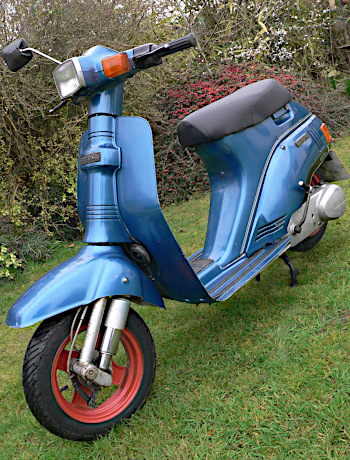
Our featured CS50DD Roadie is dated 1983 and its most remarkable feature that we’re quite looking forward to trying out, is that it’s a three-speed mechanical automatic!
The engine cylinder is almost upright, but just slightly tilted back, with 41mm bore × 37.4mm stroke, a 7.2:1 compression ratio, Mikuni VM14SH carburettor, and rated 3.5bhp@5,500rpm (assumed the same as Love/Suzy Mk2).
There’s reed-valve induction feeding into the forward crankcase, so the carburettor is fitted at the front of the engine, and forced-air cooling is driven from a fan on the electronic mag flywheel, which powers the sparks.
The exhaust port is located in the back of the cylinder, and the exhaust pipe exits in the front of the rear wheel arch, so is prone to getting sprayed by everything the rear tyre throws at it.
The wheels are pressed steel, and fitted with 3.00 × 10 tyres front and rear.
Viewed from the front, Roadie isn’t pretty, with (trying to be kind) ‘unfortunate’ styling of leg-shield centre, and a lop-sided front mudguard to cover the single-sided front suspension, while the back of the bike is really lame. This wasn’t just a stylist’s bad-hair-day, it was almost as if the Suzuki design department was infiltrated by a technical saboteur from one of its rivals! The best angle shot is taken from forward/right side front, which was the picture used on the front of the Haynes manual, otherwise it’s something of a photogenic horror.
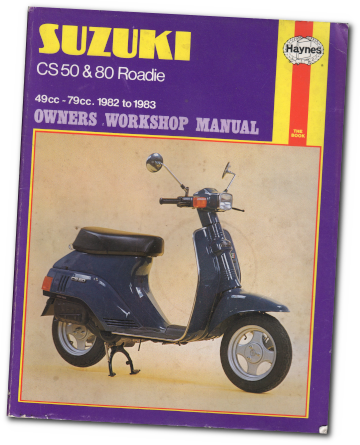
The ignition switch is located inside the leg-shield and halfway down the steering head, which will turn to lock position, or off, both with the key removable, or ignition on (key secured), and a fourth position: parking light with key removable—a surprising feature for the 1980s!
Turning on the ignition, the oil lamp appears to blink and go out, which is presumably indicating the Pozi-force oil level is OK. With a vacuum operated petrol tap and a thermal automatic choke, it looks like just pushing the start button, though you have to pull either brake on to enable the button. The starter motor sounds to be spinning, but struggles to turn the motor, so we presume the battery is past its better days.
OK, so switching to plan B and resorting to the kickstart requires the left brake lever pulling in firmly to enable the mechanism, then just one kick immediately starts the motor with a typically distinctive scooterish pop-pop-pop … just on a smaller 50cc scale.
It’s a cold February day, and it needs to run a while before it seems to clear the choke, though it still splutters a bit when we pull off, and it takes a little longer on throttle before the engine clears to respond.
First gear switches up to second between indicated 10–13mph and second changes up to third between indicated 17–20mph according to throttle and load against the drive system. On light throttle & low load the change occurs at the lower speeds, but if the throttle is wide open and the bike under maximum acceleration then the shifts hold on till the slightly higher speeds.
The ‘Roadie’ is unusual in being the only three-speed mechanical automatic that we’ve ever tested, and we don’t know of any other comparable three-speed mechanical automatics.
This seems to be the same motor unit as fitted into the two-speed CL50 Love & Suzy MkII models, but Roadie’s three-speed version has a much wider transmission case to house the triple gear/clutch train.

Opening above three-quarters throttle tends to noticeably amplify the exhaust note, which is a typical pop-pop scooter tone at low speed, and becomes a tiring wail above 30mph.
Best indicated was 36–37mph downhill, though it turned out that the speedo was indicating low, since our pacer clocked Roadie hitting 40mph downhill, and consistently running at 35–36mph along the flat.
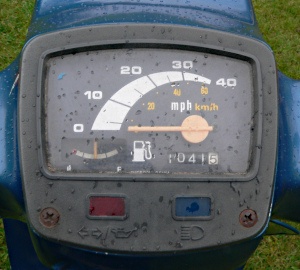
Roadie’s 0–40 speedometer is lit by an orange glow when the lights are on, and somewhat resembles a period Hi-Fi VU meter. The red oil lamp also doubles-up as an indicator flasher warning, though blinks out of flash sequence to the indicators, which seems a little odd? Nothing unusual about the blue high beam indicator, but the fuel gauge is a bit of a mystery?
Most of the preceding Honda, Suzuki. & Yamaha Japanese mini-scooters employed much the same level indicator gauge in the top of their tanks, which you had to lift the seat to see, and most of the time you couldn’t make out what it was telling you anyway—so pretty useless really. The CL50 Love/Suzy has one of these, but Roadie has an electrical fuel gauge in with the speedo set.
The odd thing about the gauge is that it continues to indicate the level even when the ignition is off. More intriguing is that when you’re filling the tank, the needle doesn’t move, until you turn on the ignition again, when it moves up to indicate the new level.
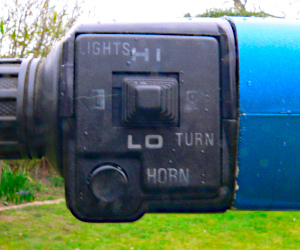
The right-hand switch cluster has the electric starter button below a slide switch for lights off–on, with a five-position sort of game controller switch on the left-hand cluster with dual-function for up beam–down dip & left indicator–middle off–right indicator, with horn button below.
There is no side-stand, only a centre-stand, which is both difficult and clumsy to lift the bike onto using a handhold beneath the saddle on the left-hand side. The handhold ‘pocket’ is too small to grasp if you’re wearing gloves, so you have to take your gloves off to lift the bike on and off the stand, and the handhold pocket also features a lock set in it to also operate as a helmet lock. The left-hand side handhold is for right-handed use, but there is no handhold on the right-hand side for left-handed use, so how a ‘leftie’ might ever manage to get a Roadie on the centre-stand might seem impossible, because there’s nothing else to handle the bike by.
In common with the majority of these period Japanese mini-scooters, handling of the Roadie is typically dreadful. Its rear spring unit is overly bouncy from the back (the damper is absolutely partied-out), and the single sided trailing-link proves twitchy at the front, so you’re best advised to either slow for bumpy bends, or hang on for grim death! A large proportioned rider will discover the rear spring is underrated as soon as they sit on the saddle, and any tall folks are going to find the cockpit quite claustrophobic. It seems like another bike designed for dainty Japanese girlies … and while the scooter may look like a two-seater, the saddle is more of a 1½ seat, and may not work out so easily with a pillion since there appear no practical places for a passenger to securely put their feet.

The seat is secured by a lock at the back and springs up from a pivot at the front to reveal the fuel tank, battery, and Pozi-force oil tank. The seat base is made from pressed steel, so typically prone to rusting out and splitting, and this one has experienced extensive welding repairs.
As you work on the Roadie, you begin to discover some ‘peculiar’ aspects of its design…
Like, if you want to access the carb … that looks very
difficult to get at! The pressed-steel section of the rear frame
assembly effectively blocks access, so only with great difficulty can
you just about get to the fuel and vacuum pipes, and twiddle with the
tickover screw through an access port, but how to remove the carb for
service seems a tricky puzzle? Let’s see what the manual says:
‘To take off the carburettor requires the engine to be removed from the
frame’—yes, really! It’s probably no surprise that when we had to
clean the carb, we rather opted for just flushing petrol through the
float chamber and out of the bowl drain. It worked, so that was a
relief.
So, you may ask, why did we need to flush out the carb? Good question –
because the float chamber was completely full of Pozi-force oil!
How was that you may ask … and, another good question.
Well, we’d found that the engine wouldn’t turn over when its loose
spark plug was tightened up, because the engine hydraulic locked with
Pozi-force oil since the crankcase had filled up until it overflowed
through the reed-valve and subsequently filled the carb!
Since modern engines don’t have any crankcase drain, the only way to
clear the crankcase was by removing the exhaust and spark plug, then
turning over the engine with a drill driver on the mag flywheel nut to
‘pump’ the oil out of the exhaust port.

OK, so having cleared all the oil out of the motor, we
have to wonder how it got there, so maybe have a look at the oil
pump? But where is the oil pump? Pozi-force pumps are more
usually driven by the engine and feed into the carb or inlet manifold,
but look around the carb and motor and there’s no sign of anything?
Pozi-force pumps are invariably connected by a secondary link to the
throttle cable, so when the throttle is opened the pump is actuated to
increase oil delivery to motor … but there’s no spur cable on the
throttle cable route.
So where is the pump?
It’s not until we’ve cleaned down the back of the engine caked with
oily dirt, that we note a small diameter pipe leading to a connection
in the back of the crankcase. The other end of the pipe seems to
disappear behind the back tyre, so remove the rear wheel and follow the
pipe back to an alloy cover which shields the oil pump at the back of
the transmission case! This means the Pozi-force pump is driven
off the transmission, so the pump will only deliver at a constant rate
when the bike is actually moving! If you’re stationary in traffic
with the engine ticking over, the pump wouldn’t be delivering at
all.
In the olden days of mineral oil, this may not have been a good idea,
but less of an issue with the advent of synthetic and semi-synthetic
oils, which are squeezed out of vaporised fuel in the bottom-end of the
engine during the under-case compression phase, then drawn into the
bearings where they are held by capillary action. So even when
the Pozi-force pump isn’t delivering, oil still remains where it needs
to be.
A number of two-speed automatic mopeds were built that pre-date the Japanese mini-scooters, but Suzuki’s three-speed mechanical automatic transmission was rather exceptional, and makes the Roadie a particularly interesting machine to ride, especially compared to the flat monotony of modern CVT systems. The Roadie has a lot going on inside its transmission case, with three separate gear trains and three separate clutches to respectively operate each gear as the engine automatically switches up and down its ratios.
There’s a lot of components and engineering going into both two-speed and three-speed mechanical automatic transmissions, and it’s easy to see how the CVT won out on simplicity and cost.
While the 6V CS50D Roadie was de-listed in March 1985, the 12V CS50DD Roadie E continued into 1988.
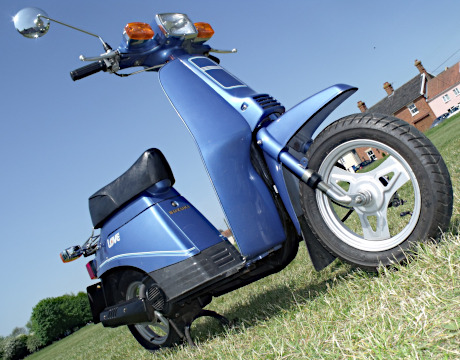
The Suzuki CL50 ‘Love’ scooter was reportedly first presented for the Japanese home market in 1982, with a 50cc four-stroke engine, and specifically marketed toward the female market since it was a small automatic mini-scooter. Other 1982 data seems to suggest that a further version with a two-stroke motor and belt CVT transmission was listed.
The following year the CL50 was introduced to Europe, but now fitted with a 50cc two-stroke engine with the established two-speed mechanical automatic transmission as proven in other Suzuki models. This was the specification of our featured model.
The engine cylinder is almost upright, but just slightly tilted back, of 41mm bore × 37.4mm stroke with a 7.2:1 compression ratio, Mikuni VM14SH carburettor, and rated 3.5bhp@5,500rpm.
There’s reed-valve induction feeding direct into the forward crankcase, so the carburettor is fitted at the front of the engine, though the Love frame appears different from the Roadie, and looks as if the smart metallic mid-blue plastic body panels would be removable to allow normal access to the carburettor. Forced-air cooling is driven from a fan on the electronic mag flywheel, which powers the sparks.
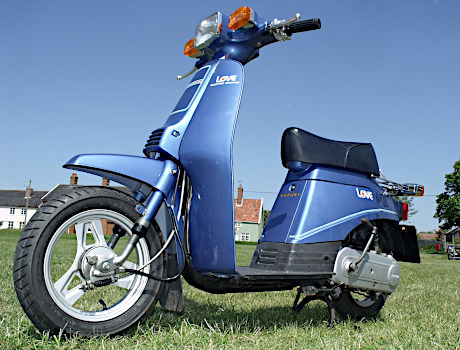
There’s the usual scooter-style single-sided rear suspension unit, but despite the exhaust pipe exiting from the back of the cylinder and into the wheel arch and prone to getting sprayed by everything the rear tyre throws at it, the pipe carries on down to the silencer, which is ideally placed to obstruct access to the rear wheel spindle, so you still have to remove the exhaust to take off the rear wheel. This seems to be the same basic motor unit that was also employed in the CS50 Roadie, but CL50 is a two-speed version with a narrower transmission case.
The CL50 ‘Love’ was introduced to the UK in March 1983, but listed as ‘Suzy MkII’ instead, and came in two formats as kickstart only (D-model) with 6V electrics, and 12V electric start (DD-model), also with kickstart.
The Suzuki FZ50N model from 1978 often seemed to have been called ‘Suzy’ in the UK, and after the CL50D & DD were introduced in March 1983, the FZ50N became formally re-designated as FZ50X ‘Suzy’ in August 1983, and continued as FZ50Z ’Suzy’ from 1984 until de-listed in March 1986. Presumably that’s why the CL50 was called ‘Suzy MkII’.
Our featured machine is a CL50DD version, ‘C’ registered in 1986, and clearly displays ‘Love’ graphics on the side-panels, but we have no idea why that is?
The centre-stand is invisible from the left-hand side, where no more than a toe-tag pokes out from under the middle of the transmission case, and a tiny little side-stand (only 5¼"/130mm) mounted off the back left-hand side of the footplate.
It wears pressed steel wheels with 2.75 × 10 tyres, and has telescopic front suspension, though with only about an inch of travel, which is a typical engineering limitation of the low bottom yoke and short legs. The chrome plated rear carrier is basically an inclusive and integral part of the back-end body assembly, since the rear indicators mount from it.
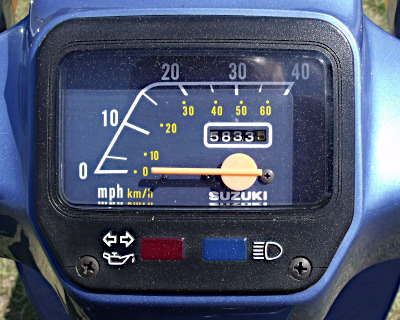
The speedo is graduated 0–40mph, with 0 at the 9 o’clock position, 30 at 12 o’clock, and 40 at 1 o’clock.
The ‘low oil’ warning lamp on the speedo doubles up its function to flash when the indicators blink. Presumably it just stays on when the oil is low? There is also a high beam warning lamp.
The single-seat has a lockable catch at the back, which uses the ignition key to release, but is difficult to get into the lock because a bar on the rack obstructs access. We’re told seat lock access is actually impossible if you have a rear carrier box fitted, in which case you’d presumably have to remove the catch from the lock? The seat folds up from the front, which we note has a plastic base, so that at least that can’t go rusty.
The petrol tank is located at the front beneath the seat, and has a built-in fuel level indicator. A 12V battery sits in the middle, and a Pozi-lube reservoir at the back.

Nice and traditional bright polished alloy levers and control brackets contain switches for lights on–off and electric start button on the right-hand throttle twist-grip side. Lights dip Hi–Lo on the left-hand lever bracket, and are operated by a rocker switch which sits on the top, but looks like it might be a possible route for letting rainwater into the switch box. Indicators operate by left–off–right switching only (there’s no push-button cancel), and a horn button below.
Love has a starter enable, electrically operated from the brake light circuit, so requires either brake lever pulling to effect the electric start. It might feel as if the kick-starter doesn’t engage, but its operation requires the back brake lever pulling in to effect the ratchet (a system that was common to the earlier FZ50, and other derivatives of the mechanical 2-speed auto system).
Located down the right-hand side of the steering head, and inside the leg-shield, the ignition switch will turn to lock or off with the key removable, or ignition on. With a vacuum operated petrol tap, and a automatic thermal choke, there isn’t anything to starting other that pushing the button, and twisting the throttle back a little to get the engine to fire … so easy!
Open the throttle and there’s a fair degree of induction draw resonating from the air box, though little discernable sound from the exhaust. The first gear is effective to take the bike up to 15mph, then switches ratio with a bit of a ‘lump’ as it changes up to second.
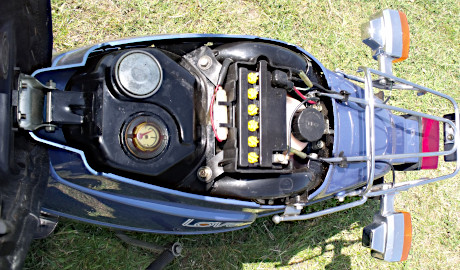
There’s generally a smooth power delivery, which doesn’t feel particularly urgent, though pulls up hills surprisingly capably, and still delivers against general inclines at only a little less than its top speed. The only brief impressions of power are felt at initial acceleration in the lower phase, and during the ‘surge’ as the ratio shifts up to second.
Suzy/Love was sat-nav paced to a best on flat of 32mph, and 35 downhill, with the speedometer displaying accurate readings.
The general engine specifications of the Love/Suzy MkII appear to be much the same as the Roadie, though their actual performances seemed to be different. Trying to find specification details isn’t so easy, and we remain unable to confirm the final drive ratio of the Love, or power rating of the Roadie motor, though presume it to be the same 3.5bhp? Certainly the exhausts were completely different, and it seemed that some performance differential might be attributable to different drive ratios between the two-speed and three-speed transmission (final drive ratio 3.487:1).
While Roadie could claim a technical advantage of three-speed transmission, Love also holds a merit of its own, as it was famously promoted by Michael Jackson! Printed adverts and filmed material can be easily found by an internet search on ‘Suzuki CL50 Love Michael Jackson advert’.
The CL50 Suzy MkII D 6V kickstart and DD 12V electric-start models were both discontinued in Feb 1987. There was a CX50D Love III model with CVT transmission and 6hp rated engine listed from 1984, but not available in the UK.

